Abstract
Let G be a group. A k-coloring of G is a surjection . Equivalently, a k-coloring of G is a partition of G into k subsets. If for all g in G, we say that is perfect. If only for all such that , then is semiperfect. If there is an element such that for all , then is said to be symmetric. In this research, we relate the notion of symmetric colorings with perfect and semiperfect colorings. Specifically, we identify which perfect and semiperfect colorings are symmetric in relation to the subgroups of G that contain the squares of elements in G, in H, and in . We also show examples of colored planar patterns that represent symmetric perfect and symmetric semiperfect colorings of some groups.
MSC:
05A18; 05C25; 20F65; 52C20; 58D19
1. Introduction
The study of color symmetry, whose motivation comes primarily from the field of art, has generated interest in recent years due to its applications in branches of science like chemistry and biology. For instance, the crystal structure of different crystalline materials can be modeled using colored tilings [1]. In physics and materials engineering, nanotubes with several types of atoms such as carbon–boron nitride are characterized by constructing colorings of the associated single-wall carbon nanotube [2]. Apart from these applications, color symmetry in itself provides an enjoyable way of learning fundamental concepts in group theory and geometry by analyzing aesthetically pleasing designs and colored patterns like those of Escher.
Shubnikov’s work on antisymmetry laid the foundations for the study of color symmetry (see [3,4,5]). Since then, concepts orbiting around colored patterns in the Euclidean plane and in higher-dimensional spaces have been explored and a great level of enthusiasm has been achieved, leading to numerous studies in the area. One such study was carried out by Grunbaum and Shephard in [6], where the notion of a perfect coloring was formally defined. In [7], the relationship between group theory and color symmetry was extensively discussed. These eventually led to a coloring framework in [8] that resulted in a method to come up with perfect colorings of any symmetrical object. On the matter of semiperfect colorings, Felix and Loquias [9] gave results on how to obtain all semiperfect colorings of any symmetrical pattern.
In [10], Gryshko introduced the idea of symmetric colorings of groups and was initially motivated by colorings of the vertices of regular polygons. However, the origins of symmetric colorings can be traced back to [11] using the concept originally known as symmetries of groups. Subsequent studies on symmetric colorings dealt with various groups, as can be seen in [12,13,14,15,16]. In contribution to this stage wherein concepts on color symmetry are being generalized, this research aims to relate the concept of perfect and semiperfect colorings with symmetric colorings. As of this writing, no article has been published yet that connects these different types of colorings. In this present work, we derive conditions so that a perfect coloring and a semiperfect coloring of a group are also symmetric. We also present colored patterns to represent symmetric perfect colorings and symmetric semiperfect colorings of certain groups.
2. Preliminaries
Let be (the set of objects in) a given pattern to be colored and let G be a group acting on . If , the G-orbit of x is the set , while the stabilizer of is given by . Throughout this paper, we observe the coloring setting considered in [9]: G acts transitively on , and for all , . With this, we obtain a one-to-one correspondence between G and given by . As a consequence, we can associate a partition of G with the partition of . If is a set of k colors, the bijection is called a k-coloring of that corresponds to the partition of G. We can therefore regard a coloring of a pattern as a partition of G with every element of representing a unique color. This allows us to make the following natural definition. A k-coloring of a group G is an onto function from G to a set of k colors where is the color assigned to an element . Simply speaking, a k-coloring of a group G is just a partition of G into k subsets where is the set of elements of G assigned the color .
Let be the set of all partitions of G. Then the group G acts on by left multiplication. If , let H be the stabilizer of . Then . The partition is referred to as an H-invariant partition of G. The coloring of G is called perfect if , that is, if . Whenever , the coloring is called semiperfect. As regards the pattern , an element permutes the colors in the coloring of that correspond to the partition of G. A perfect coloring of is one for which every element of G effects a permutation of . If the only elements of G that permute the colors in the coloring of belong to an index-2 subgroup H of G, the coloring is semiperfect. We emphasize that the definitions of perfect and semiperfect colorings of patterns are old notions. What is new here are the concepts of perfect and semiperfect colorings of groups. These arise from the equivalence among the three sets considered in the previous paragraph given our coloring setting.
Perfect colorings of patterns have been characterized in [8] where sufficient and necessary conditions for a coloring to be perfect are determined. In particular, Theorem 5 of the said article shows that a coloring of a set forming only one G-orbit is perfect if and only if it is given by the partition , where , and . Since we require that for all , then any subgroup of G can be used to come up with a perfect coloring of . This translates to the following result regarding perfect colorings of groups.
Theorem 1.
Let G be a group. A coloring of G is perfect if and only if it is given by the partition where J is any subgroup of G.
By the above theorem, every perfect group coloring is always a partition of G by left cosets of a subgroup J. In the case where , the coloring given by is a perfect k-coloring of G. If , we obtain a trivial coloring of G using only one color. If , then all the elements of G obtain distinct colors.
Semiperfect colorings of patterns are studied in [9] where it was shown that every such coloring falls under one of two possible types of partition of a group G. The next two theorems are restatements of results of [9] on semiperfect colorings.
Theorem 2
(Type I Semiperfect Coloring). Let with , , and . The partition of G given by is a semiperfect coloring of G if and only if or .
Theorem 3
(Type II Semiperfect Coloring). Let with , , and . The partition of G given by is a semiperfect coloring of G if and only if .
Note that both and are H-invariant partitions of G, that is, and . corresponds to a perfect coloring of G if and only if (or , the normalizer of J in G) and . Moreover, if , the partition will yield a coloring of G with only one color and thus be perfect. For the partition , a perfect coloring of G is obtained whenever .
Next, we define what it means for a coloring of a group to be symmetric. Given a group G, the mappings where are called symmetries of G [11]. In [16] and other related articles by the same author, a k-coloring of a group G is defined as any map without the condition of being surjective. We adhere to our previous definition so that a k-coloring remains as a partitioning of G into k subsets. Now, we say that a coloring of G is symmetric if there is a such that for all . In essence, is symmetric if the elements x and have the same color.
We say that and are equivalent colorings of G if for some . The following result from [9] gives all equivalent H-partitions of a group G if .
Theorem 4.
Let G be a group and an H-invariant partition of G. If then there are only two partitions of G that are equivalent to , namely, and , for some . Moreover, the stabilizer of in G is also H.
Note that in listing symmetric colorings of groups, we do not distinguish between partitions and which are equivalent colorings.
In this paper, we are interested in determining which perfect colorings and semiperfect colorings of a group G are symmetric with respect to some element . We first consider perfect colorings of G and derive conditions for this coloring to be symmetric. Next, we consider the two types of semiperfect colorings of G described in Theorems 2 and 3. We give conditions for a Type II semiperfect coloring of G to be symmetric. We also show that no Type I semiperfect colorings of G are symmetric. Lastly, we give actual symmetric perfect colorings and symmetric semiperfect colorings of some groups that can be represented by planar patterns.
3. Results
We start this section by describing symmetric perfect colorings. Note that from Theorem 1, the coloring of a group G given by the partition where gives a perfect coloring. The next theorem gives the condition for a perfect coloring to be symmetric.
Theorem 5.
Let G be a group and let J be a subgroup of G. The coloring of G given by the partition yields a symmetric perfect coloring with respect to some if and only if J contains .
Proof.
Suppose the coloring of G induced by the left cosets of J is symmetric with respect to some . Then , , implying that . Thus .
On the other hand, if then for all . Thus for all , . Hence, the coloring is symmetric with respect to any . □
Using Theorem 5, we may obtain symmetric perfect colorings of a group G by observing the following procedure:
- Form the group .
- Choose a subgroup J of G such that .
- Form the partition .
We note that if the left coset coloring of G induced by J is symmetric with respect to some , then the coloring is symmetric with respect to every element of G. By Theorem 5, the number of proper subgroups of G that contain the set is the number of inequivalent symmetric nontrivial perfect colorings of G. Let and consider the partitions and . If and are equivalent, then there exists such that . This implies that for some . As both J and are subgroups of G, we must have . We have therefore shown that distinct subgroups of G containing give rise to inequivalent symmetric perfect colorings of G.
Moreover, we note that is a normal subgroup of G and that the quotient is an abelian group whose non-identity elements are of order 2. Thus, can be viewed as a vector space over and each subgroup J containing is a lifting of a subspace of . This implies that the number of such J (and thus the number of symmetric perfect colorings of G) is a sum of 2-binomial coefficients.
Theorem 5 has many other consequences. For instance, a group G of odd order has only the trivial coloring which is symmetric perfect since . For a cyclic group G of order n, either G has exactly one or no nontrivial symmetric perfect coloring depending on whether n is even or odd. Also, a finite non-abelian simple group has only the trivial coloring as a perfect symmetric coloring.
Next, we derive conditions such that a semiperfect group coloring is also symmetric. For now, we postpone our search for symmetric Type I semiperfect colorings and proceed to identifying Type II semiperfect group colorings that are symmetric. By Theorem 3, recall that the partition is a semiperfect coloring of G if and only if where are subgroups of an index-2 subgroup H of G and .
Suppose is a symmetric coloring with respect to and let
If , then for some . That is, . Since the coloring is symmetric with respect to g, we have . Since , we have for all . Thus, for all .
If , then for some . That is, . Since the coloring is symmetric with respect to g, we have . Since , we have for all . Thus, for all .
We formalize these results below.
Theorem 6.
Let G be a group and let such that . Fix and choose subgroups of H. The partition given by corresponds to a symmetric semiperfect coloring of G with respect to if and only if the following conditions are satisfied:
- ;
- for all ;
- for all .
If a semiperfect coloring of Type II is symmetric with respect to some , then conditions (2) and (3) of the theorem above give the following cases: (i) the coloring is symmetric with respect to all ; (ii) the coloring is symmetric with respect to all ; and (iii) the coloring is symmetric with respect to all . The following result is immediate from Theorem 6.
Corollary 1.
Consider the partition of G where , , and . Then, the following hold:
- is symmetric with respect to an element if and only if for all and for all .
- is symmetric with respect to an element if and only if for all and for all .
Certainly, if and both contain , then the coloring is symmetric with respect to every element .
Similar to what was done for symmetric perfect colorings of G, we give a method on how to obtain symmetric semiperfect colorings of a group G. The following steps need to be carried out to attain the required colorings:
- Choose a subgroup H of G such that .
- Compute and .
- Find with and with where .
- Form the partition where .
In [9], it was established that the number of inequivalent semiperfect colorings of Type II for a given index-2 subgroup H is equal to where n is the number of subgroups of H. With the conditions imposed in Theorem 6 on the subgroups and , it is reasonable to expect that for most groups, the number of symmetric Type II semiperfect colorings of a group is less than . An illustration will be given in the next section.
We now show that there exists no nontrivial symmetric Type I semiperfect coloring of any group.
Let G be a group and let such that . Fix and let J be a proper subgroup of H. Suppose that the partition given by corresponds to a symmetric coloring of G with respect to some .
Let . Then for some . This implies that either or . Now, since the coloring is symmetric with respect to g, then or . We consider two cases.
If , then and either or . If , it follows that and its inverse are in J. Meanwhile, or . We thus obtain or . Hence, for all .
If , then and either or . If , then and its inverse are in J. Similar computations yield for all x not in H.
By the computations above, the partition given by corresponds to a symmetric coloring of G with respect to if and only if the following conditions are satisfied:
- (1)
- for all ;
- (2)
- for all .
Now, so for all . Since and , the cosets and are both outside H. Hence, (1) can be rewritten as for all while (2) becomes for all . Depending on whether g is found in H or not, conditions (1) and (2) give the following possibilities:
- (a)
- for all and for all ;
- (b)
- for all and for all .
Suppose that (a) holds. Since y is outside H, then . So we have for all . It follows that . But are all the elements outside H as h runs through all the elements of H. This implies that the squares of all the elements of are also in J. Thus, J contains the squares of all the elements of G. If (b) is assumed to be true, then similar arguments imply that J also contains the set . In particular, . Moreover, since , then J is normal in G, which implies that and thus . But Theorem 2 requires that or so that corresponds to a semiperfect coloring of G. We have therefore proved the following theorem.
Theorem 7.
Let H be an index-2 subgroup of G, , and . No partition of G of the form yields a symmetric semiperfect coloring, that is, there exists no symmetric Type I semiperfect group coloring for any group G.
4. Examples
To illustrate the results in the previous section, we consider the dihedral group , the group , and the triangle group . In all the examples, patterns using right triangles are used to represent every group G where each right triangle corresponds to an element of the group. In fact, the elements of the group are all the plane isometries that leave the pattern unchanged. In other words, G is the symmetry group of the pattern. For and , the program GAP [17] is used to obtain all the required subgroups. Note that all symmetric semiperfect colorings presented here are only those that are consistent with partitions given by , as no Type I semiperfect colorings exist which are symmetric.
4.1. Colorings of
We represent the elements of the diheral group as -- triangles whose union is the hexagonal pattern shown in Figure 1a. Here, a represents a counterclockwise rotation about the center of the hexagon, while b is a mirror reflection about the horizontal line passing through the center of the hexagon. From Theorem 5, to find all the symmetric perfect colorings of , we only need to determine all the subgroups of that contain the subgroup generated by squares. This subgroup of is . There exist four proper subgroups of which contain S, namely , , , and . The corresponding colorings by left cosets of , are shown in Figure 1b–e. Therefore, has four inequivalent symmetric perfect colorings.
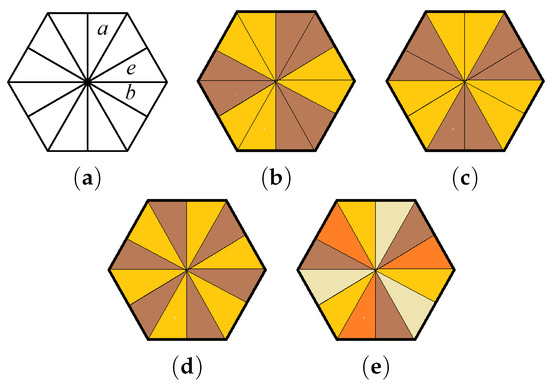
Figure 1.
(a) A hexagonal pattern consisting of right triangles with some of the triangles labeled with the generators of the group . (b–e) Symmetric perfect colorings of the dihedral group .
For the symmetric semiperfect colorings of , we look for all partitions of the group based on Theorem 6. There are three index-2 subgroups of , namely , , and . For each of these index-2 subgroups of G, we choose the subgroups and such that conditions (1)–(3) are fulfilled. Table 1 shows the possible combinations of and relative to every subgroup () of of index 2. The resulting seven inequivalent symmetric semiperfect colorings are shown in Figure 2. Observe that and are equivalent colorings according to Theorem 4.

Table 1.
Subgroups and that can be used to construct the coloring for each index-2 subgroup H of .
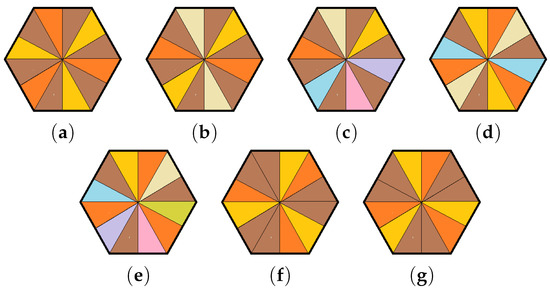
Figure 2.
(a–e) Symmetric semiperfect colorings of induced by the subgroup . (f) Symmetric semiperfect coloring of induced by the subgroup . (g) Symmetric semiperfect coloring of induced by the subgroup .
For instance, the coloring in Figure 2a is described by the set where , , and . If the roles of and are interchanged, we obtain the coloring which is equivalent to since for any . Note that is symmetric with respect to every since both and contain the set of squares of elements of . In contrast, the coloring in Figure 2e is only symmetric with respect to each . However, an equivalent coloring given by is symmetric only with respect to all the elements outside . These can be verified from Table 2.

Table 2.
The elements x and for all .
Notice that has four distinct subgroups and so we expect a total of inequivalent Type II semiperfect colorings of that arise from . Of these six possible colorings, five are symmetric (Figure 2a–e). The one left out is the partition with and , as none of these subgroups contain . It is also worth mentioning that each of and has six subgroups. However, there is only one symmetric semiperfect coloring that results from each of these subgroups (Figure 2f,g).
4.2. Colorings of
We now look at symmetric perfect and symmetric semiperfect colorings of the group , also denoted , which is the symmetry group of a frieze pattern of type . In Figure 3, we see a portion of an infinite strip that is left invariant by G with some of the triangles labeled using the generators of . Here, h is a mirror reflection with a horizontal axis indicated by the green line, v is a mirror reflection with a vertical axis represented by the red line, and t is the translation given by the blue vector. Note that the aforementioned isometries leave the pattern unchanged. The subgroup generated by squares of the elements of is . Using GAP, we obtain 15 nontrivial subgroups of that contain S. These subgroups are given in Table 3 with the corresponding colorings shown in Figure 4 in the order by which the subgroups appear in the table.

Figure 3.
Generators of as labels of some tiles of a frieze pattern of type .

Table 3.
Subgroups of that contain .

Figure 4.
(a–o) Symmetric perfect colorings of .
By Theorem 6, we can obtain symmetric semiperfect colorings of given any index-2 subgroup H of G by choosing the appropriate subgroups and of H. We see in Table 3 seven index-2 subgroups of G, which are in fact all the index-2 subgroups of G. Let us take . Note that the set of squares of all the elements in H is , which is also the set of squares of all the elements in . Therefore, we need (). From GAP, there are five subgroups of H that satisfy this inclusion: H, , , , and . Since , there are exactly 10 inequivalent symmetric semiperfect colorings of relative to the subgroup H. All the said colorings, presented in Figure 5, are symmetric with respect to any element . Note that these are not all the symmetric semiperfect colorings of but only the symmetric colorings that are invariant under the subgroup . The rest of the index-2 subgroups of G will yield more symmetric semiperfect colorings of G.
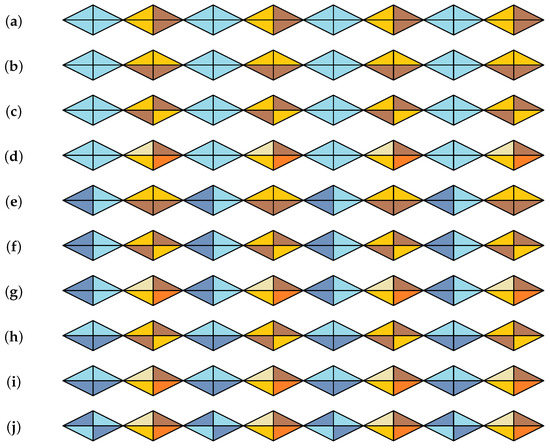
Figure 5.
(a–j) Symmetric semiperfect colorings of induced by the subgroup .
4.3. Colorings of
We finish this section by giving examples of colorings of the triangle group . This particular group is defined by . Geometrically, and r can be taken as the mirror reflections along the lines containing the sides of a triangle e whose interior angles are of measure , , and (see Figure 6), with the axes of the reflections p, q, and r opposite to the angles , , and , respectively.
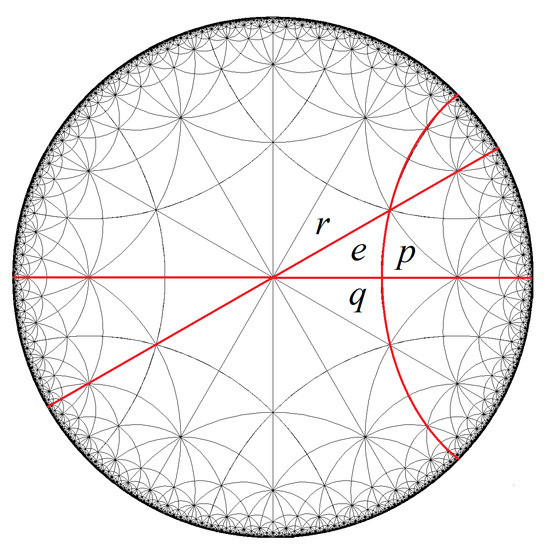
Figure 6.
Generators of as labels of some tiles of a hyperbolic tiling by triangles with interior angles , , and .
In Figure 7a, we see a symmetric perfect coloring of that corresponds to the partition where , an index-4 subgroup of which contains the subgroup of squares of elements of G. Figure 7b is another symmetric perfect coloring of induced by the index-2 subgroup . Using this subgroup H, we obtain the symmetric semiperfect coloring of in Figure 7c, which is described by the partition where , and . As with the group , has other symmetric semiperfect colorings arising from each index-2 subgroup of . All these subgroups, together with all the others that contain , which can be used to form symmetric perfect colorings of , are found in Table 4.
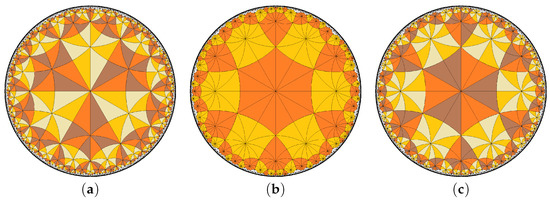
Figure 7.
(a,b) Symmetric perfect colorings of . (c) Symmetric semiperfect coloring of the group induced by the subgroup .

Table 4.
Subgroups of that contain .
5. Conclusions and Outlook
This paper focuses on the relationship between various concepts in group colorings. Specifically, we provide a characterization of symmetric perfect and semiperfect group colorings. Among the two possible partition types for semiperfect group colorings, we demonstrate the nonexistence of symmetric colorings for the first type. By investigating these different notions of group colorings, we aim to deepen our understanding of their properties and shed light on the interplay between symmetry and perfect/semiperfect colorings.
We present constructions of symmetric perfect colorings and symmetric semiperfect colorings using the dihedral group , the frieze group , and the triangle group . To facilitate practical implementation, we provide an algorithm that outlines the step-by-step process for obtaining all the symmetric perfect colorings and symmetric semiperfect colorings of any group G.
In this study, our primary focus was to investigate colorings of patterns, where each tile within a given pattern corresponds uniquely to an element in the symmetry group G associated with that pattern. It is worth noting that there are additional avenues in the realm of pattern colorings, such as considering cases where the tiles in a pattern are not necessarily in one-to-one correspondence with the elements of its symmetry group. By expanding the scope of investigation to encompass such scenarios, researchers may uncover and analyze various methods of coloring a given pattern that will yield other symmetric perfect and symmetric semiperfect colorings.
Furthermore, exploring symmetric colorings of group partitions that are invariant under subgroup H, where the index is greater than or equal to three (), could also be an intriguing avenue of investigation.
Author Contributions
The authors confirm contribution to the paper as follows: Conceptualization, R.B.S., L.D.V. and M.L.B.W.; Formal analysis, R.B.S., L.D.V. and M.L.B.W.; Funding acquisition, R.B.S., L.D.V. and M.L.B.W.; Investigation, R.B.S., L.D.V. and M.L.B.W.; Project administration, R.B.S.; Writing—original draft, R.B.S. and L.D.V.; Writing—review and editing, R.B.S. and L.D.V. All authors have read and agreed to the published version of the manuscript.
Funding
This research was funded by the Natural Sciences Research Institute, University of the Philippines Diliman [Project Code MAT-18-1-04].
Institutional Review Board Statement
Not applicable.
Data Availability Statement
Not applicable.
Acknowledgments
This article is dedicated to the memory of our mentor, René P. Felix. The authors are grateful to the anonymous reviewers for their valuable remarks, which have helped improve the quality of the paper.
Conflicts of Interest
The authors declare no conflict of interest.
References
- Lifshitz, R. Theory of color symmetry for periodic and quasiperiodic crystals. Rev. Mod. Phys. 1997, 69, 1181–1218. [Google Scholar] [CrossRef]
- Loyola, M.; De Las Peñas, M.L.A.; Basilio, A. Colorings of single-wall carbon nanotubes. Z. Krist.—Cryst. Mater. 2012, 227, 672–680. [Google Scholar] [CrossRef]
- Schwarzenberger, R.L.E. Colour symmetry. Bull. Lond. Math. Soc. 1984, 16, 209–240. [Google Scholar] [CrossRef]
- Senechal, M. Coloring symmetrical objects symmetrically. Math. Mag. 1983, 56, 3–16. [Google Scholar] [CrossRef]
- Senechal, M. Color Symmetry. Comput. Math. Appl. 1988, 16, 545–553. [Google Scholar] [CrossRef]
- Grunbaum, B.; Shephard, C. Perfect colorings of transitive tilings and patterns in the plane. Discret. Math. 1977, 20, 235–247. [Google Scholar] [CrossRef]
- Roth, R.L. Color symmetry and group theory. Discret. Math. 1982, 38, 273–296. [Google Scholar] [CrossRef]
- Junio, A.; Walo, M.L. Perfect colorings of patterns with multiple orbits. Acta Crystallogr. Sect. A Found. Crystallogr. 2019, 75, 814–826. [Google Scholar] [CrossRef] [PubMed]
- Felix, R.; Loquias, M.J. Enumerating and identifying semiperfect colorings of symmetrical patterns. Z. Krist. 2008, 223, 483–491. [Google Scholar] [CrossRef]
- Gryshko, Y. Symmetric Subsets and Colorings of Groups. Ph.D. Dissertation, Kyiv Taras Shevchenko University, Kyiv, Ukraine, 2002. [Google Scholar]
- Loos, O. Symmetric Spaces; Benjamin: New York, NY, USA, 1969; pp. 63–118. [Google Scholar]
- Gryshko, Y. Symmetric colorings of regular polygons. Ars Combin. 2006, 78, 277–281. [Google Scholar]
- Phakathi, J.; Radnell, D.; Zelenyuk, Y. The number of symmetric colorings of the dihedral group Dp. Appl. Math. Inf. Sci. 2016, 10, 2373–2376. [Google Scholar] [CrossRef]
- Zelenyuk, Y. Monochrome symmetric subsets in colorings of finite abelian groups. Symmetry 2011, 3, 126–133. [Google Scholar] [CrossRef]
- Zelenyuk, Y. The number of symmetric colorings of the quaternion group. Symmetry 2010, 2, 69–75. [Google Scholar] [CrossRef]
- Zelenyuk, Y. Symmetric colorings of finite groups. In Groups St Andrews 2009 in Bath; LMS Lecture Note Series; Cambridge University Press: Cambridge, UK, 2011; Volume 338, pp. 580–590. [Google Scholar]
- The GAP Group. GAP—Groups, Algorithms, and Programming, Version 4.4.12. 2008. Available online: http://www.gap-system.org (accessed on 24 February 2023).
Disclaimer/Publisher’s Note: The statements, opinions and data contained in all publications are solely those of the individual author(s) and contributor(s) and not of MDPI and/or the editor(s). MDPI and/or the editor(s) disclaim responsibility for any injury to people or property resulting from any ideas, methods, instructions or products referred to in the content. |
© 2023 by the authors. Licensee MDPI, Basel, Switzerland. This article is an open access article distributed under the terms and conditions of the Creative Commons Attribution (CC BY) license (https://creativecommons.org/licenses/by/4.0/).